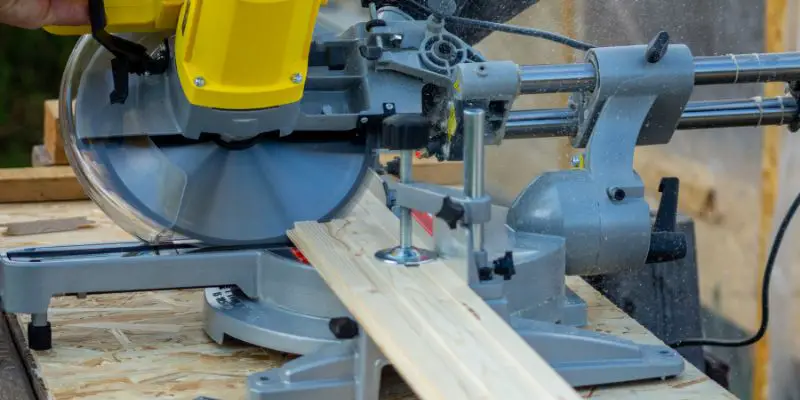A single bevel miter saw is a type of power tool used for making angled cuts in wood or other materials. It has a blade that tilts to one side for cutting bevels in one direction.
A single bevel miter saw is a versatile and essential tool for woodworking and construction projects. Its ability to make precise angled cuts makes it ideal for creating frames, molding, and trim work. The single bevel design means the saw tilts in one direction, making it suitable for most cutting tasks but may require repositioning for certain bevel cuts.
This saw is popular among DIY enthusiasts and professional carpenters for its accuracy and ease of use. With the ability to cut both miter and bevel angles, it’s a valuable addition to any workshop or job site.
Essential Miter Saw Anatomy
When it comes to essential miter saw anatomy, it is crucial to understand the core components, distinguishing features, and the role of the single bevel. A miter saw is a versatile power tool designed for making accurate crosscuts and precise angles in wood, metal, or other materials. By recognizing the key components and features of a single bevel miter saw, you can harness its capabilities to accomplish a wide range of cutting tasks.
Core Components To Recognize
When examining the essential anatomy of a single bevel miter saw, it’s important to recognize the following core components:
- Blade guard
- Fence system
- Miter scale
- Bevel adjustment
- Trigger and handle
- Dust collection system
Distinguishing Features
The distinguishing features of a single bevel miter saw encompass its ability to make bevel cuts in a single direction. This means the saw can tilt to the left, allowing for precise angled cuts without the need to adjust the material. Additionally, the saw may feature laser guides or LED lights to enhance cutting accuracy and visibility, as well as a sliding arm mechanism for increased cutting capacity.
The Role Of The Single Bevel
The single bevel serves to enhance the efficiency and versatility of the miter saw. By enabling the saw to tilt in a single direction, it eliminates the need for adjusting the material when making bevel cuts. This feature streamlines the cutting process, saving time and effort while maintaining accuracy and precision.

Utilizing Single Bevel Miter Saws
Basic Operations For Woodcutting
When using a single bevel miter saw for woodcutting, it’s important to understand the basic operations to achieve precise and accurate cuts. This includes properly setting up the saw, selecting the appropriate blade, and ensuring safety measures are in place before starting any cutting tasks.
Angular And Bevel Cuts Explained
Single bevel miter saws are perfect for making angular and bevel cuts on wood. Angular cuts can be set at a specific angle to create miter joints, while bevel cuts involve tilting the blade to one side for creating compound angles. Understanding how to adjust the saw for angular and bevel cuts is crucial for carpentry projects that involve intricate woodwork.
Setting Up For Different Projects, Ensuring Each Heading Adheres To Html Syntax
When setting up a single bevel miter saw for different projects, it’s essential to consider the specific requirements of the task at hand. This may involve adjusting the angle and bevel settings, changing the blade for different types of cuts, and using appropriate clamping and support to ensure the workpiece stays in place during cutting.
Advantages Of Single Bevel Designs
Single bevel miter saws are a popular choice for woodworking and construction professionals due to their numerous advantages over other types of miter saws. These saws are designed to provide precise angled cuts with their unique single bevel feature, making them highly efficient and versatile tools. In this section, we will delve into the advantages of single bevel designs, focusing on their cost efficiency, suitability for specific tasks, and ease of use and maintenance.
Cost Efficiency
Single bevel miter saws are known for their cost efficiency, making them a practical choice for both professional woodworkers and DIY enthusiasts. These saws typically come at a more affordable price point compared to their dual bevel counterparts, allowing users to save money without compromising on performance. Additionally, the cost efficiency extends to the maintenance of single bevel miter saws, as they often require less frequent servicing and upkeep, resulting in long-term cost savings.
Suitability For Specific Tasks
Single bevel miter saws are highly suitable for specific woodworking tasks that involve angled cuts in one direction. Their ability to tilt in a single direction makes them ideal for projects that primarily require bevel cuts on one side of the workpiece. This makes them particularly useful for projects such as crown molding, picture frames, and trim work, where angled cuts are a primary requirement. The design of single bevel miter saws allows for precise, accurate cuts, ensuring that the end result meets professional standards.
Ease Of Use And Maintenance
One of the key advantages of single bevel miter saws is their ease of use and maintenance. These saws are designed to be user-friendly, with intuitive controls and ergonomic features that make them easy to operate, even for beginners. Additionally, their single bevel design simplifies the cutting process, reducing the need for complex adjustments and setup. When it comes to maintenance, single bevel miter saws are known for their durability and reliability, requiring minimal upkeep to ensure consistent performance over time.
Comparing Single And Dual Bevel Miter Saws
When it comes to selecting the right miter saw for your upcoming projects, understanding the differences between single and dual bevel miter saws is essential. Both types have their unique characteristics and applications, so it’s crucial to make an informed decision based on your specific needs and preferences. Let’s delve into the key differences in motion, project suitability, and considerations for purchase to help you determine which type of miter saw will best suit your requirements.
Key Differences In Motion
When comparing single and dual bevel miter saws, one of the pivotal differences lies in their beveling capabilities. A single bevel miter saw can only tilt in one direction, typically to the left, while a dual bevel miter saw is designed to tilt both left and right. This means that with a single bevel saw, you need to manually adjust your material when making bevel cuts in the opposite direction, leading to more time and effort spent on each cut. On the other hand, a dual bevel miter saw allows you to tilt the blade in either direction without having to flip your workpiece, resulting in increased efficiency and precision.
Project Suitability
Single bevel miter saws are ideal for straightforward, single-sided bevel cuts on materials such as wood, plastic, and some metals. They are well-suited for general woodworking tasks, framing, and trim work. In contrast, dual bevel miter saws offer greater versatility, making them suitable for complex projects that require bevel cuts in multiple directions, such as crown molding, large-scale furniture making, and more intricate woodworking projects. Their ability to tilt in both directions makes them a valuable tool for professionals and hobbyists alike, especially when working on complex or ornate designs.
Considerations For Purchase
When considering the purchase of a miter saw, it’s essential to factor in the type of projects you typically work on, as well as your preferred workflow and level of precision required. Additionally, assessing the available workspace and potential budget constraints will also influence your decision. Single bevel miter saws generally come at a lower price point and are more compact, suitable for DIY enthusiasts or those with limited space. On the other hand, dual bevel miter saws offer added convenience and efficiency, albeit at a higher cost and larger footprint. Evaluating these aspects will help you make an informed choice that aligns with your specific needs.

Tips For Accurate Single Bevel Cuts
When it comes to achieving precise woodworking, utilizing a single bevel miter saw can be an invaluable tool. The accuracy of single bevel cuts can significantly impact the quality and appearance of your projects. Here are essential tips to ensure accurate single bevel cuts, covering measuring and marking workflow, blade alignment and handling, and mitigating common errors.
Measuring And Marking Workflow
One of the most critical aspects of obtaining accurate single bevel cuts is establishing a meticulous measuring and marking workflow. To ensure precision, follow these steps:
- Measure and mark the material accurately using a quality tape measure and a sharp marking tool.
- Double-check measurements to prevent any potential errors.
- Use clear and visible marks to guide the saw blade during the cutting process.
Blade Alignment And Handling
The alignment and handling of the saw blade play a pivotal role in achieving accurate single bevel cuts. Here’s what you should focus on:
- Regularly check and adjust the blade alignment to ensure it’s perpendicular to the material being cut.
- Handle the saw with care and maintain a firm grip to ensure stability and precision during the cutting process.
- Use appropriate safety equipment such as eye protection and dust masks to protect yourself from potential hazards.
Mitigating Common Errors
To guarantee the accuracy of single bevel cuts, it’s essential to be aware of common errors and how to avoid them. Consider the following:
| Common Error | Mitigation Strategy |
|---|---|
| Material shifting during cutting | Utilize clamps to secure the material firmly in place before making cuts. |
| Inaccurate angle settings | Regularly check and calibrate the bevel angle to ensure precise cuts. |
| Uneven cutting surface | Support the material adequately to maintain a level cutting surface. |
Frequently Asked Questions On What Is A Single Bevel Miter Saw
What Is A Single Bevel Miter Saw Used For?
A single bevel miter saw is used for making angled cuts in wood, often used for trim work or framing. Its single bevel feature allows cutting bevels in one direction, making it versatile for various woodworking projects.
How Does A Single Bevel Miter Saw Differ From A Dual Bevel Saw?
Unlike a dual bevel miter saw, a single bevel miter saw tilts in one direction only, requiring the wood to be flipped for bevel cuts in the opposite direction. This difference affects the efficiency and convenience of making bevel cuts in woodworking projects.
What Are The Advantages Of Using A Single Bevel Miter Saw?
The single bevel miter saw offers simplicity in operations, making it more affordable and suitable for beginners. Its lightweight and compact design make it portable and easy to use on job sites or in small workshops.
Conclusion
A single bevel miter saw is a versatile tool for precise woodworking. Its ability to make bevel cuts in one direction enhances efficiency and accuracy. This saw is suitable for both beginners and professionals, offering ease of use and reliable performance.
Invest in a single bevel miter saw to elevate your woodworking projects.


